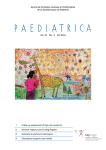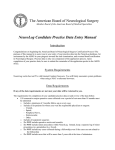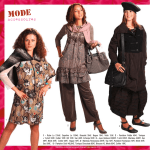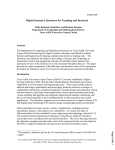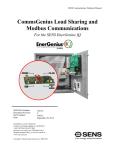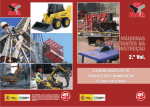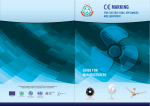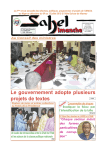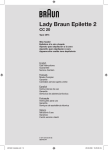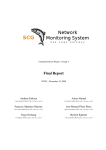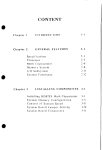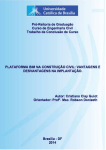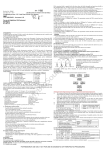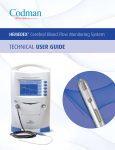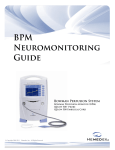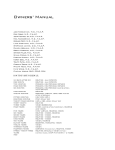Download EGNN Dataset Definitions Manual - Egyptian Neonatal Network for
Transcript
Egyptian Neonatal Network for Training Pediatricians "Egyptian Neonatal Network for Training Pediatricians" Project Consortium Europe: Spain “Fundación Vasca de Innovación e Investigación Sanitarias/Cruces University Hospital" - Professor Adolf Valls-i-Soler Germany University of Ulm – Professor Helmut.Hummler UK University of Liverpool Professor Michael Weindling Egypt: Ain Shams University - Professor Samy Shemi AlAzhar University - Professor Safaa Al Menazaa Alexandria University - Professor AbdelHaleem Badreldin Mansoura University - Professor Mohamed Reda Bassiouny Tanta University - Professor Mohamed Rowisha Project Experts: Hesham Fathy, MD – Professor of Pediatrics, Suez canal University Nahed Fahmy, MD – Professor of Pediatrics, Cairo University Project Director Mohamed Reda Bassiouny MD, MHPE - Professor of Pediatrics/Neonatology Mansoura University Project Co-director Amr AlShahed, MD, Lecturer of Pediatrics – Mansoura University Consultant Neonatologist Egyptian Neonatal Network for Training Pediatricians Egyptian Neonatal Network (EGNN) Advisory Committee Professor Adolf Valls-i-Soler - Spain Professor Helmut Hummler – Germany Professor Michael Weindling – UK Dr Suzanne Farhoud - Regional Adviser - Child and Adolescent Health and Development - WHO/EMRO Dr. Vijayakumar Moses - Chief, Young Child Survival and Development –YCSD UNICEF Dr. Magdy El-Sanady - Health Specialist, UNICEF Egypt Prof. Ashraf Shallan - President of National Research Center -Egypt Prof. Gamal Samy - President of Egyptian Society of Neonatal and Premature care – Egypt Prof. Maha Mourad - Assistant Minister of Ministry of State for Family and Population - Egypt Prof. Nadia Badrawi - President of Egyptian Association of Neonatology – Egypt, President of ANQAHE 1 "Egyptian Neonatal Network (EGNN) Dataset Manual, 2010" Egyptian Neonatal Network for Training Pediatricians Dataset Manual Review Panel Professor Adolf Valls-i-Soler - Professor of Pediatrics, University of the Basque Country, Hospital de Cruces, Plaza de Cruces s/n, Barakaldo-Bilbao, Bizkaia, Spain Professor Helmut Hummler - Head of Department of Pediatrics, University of Ulm – Germany Professor AbdelHaleem Badreldin - Professor of Pediatrics, Alexandria University, Egypt Professor Maha Mourad, Professor of Pediatrics, Assistant Minister of the Ministry of State for Family and Population- Egypt Professor Gamal Samy –President of Egyptian Society of premature and newborn care, Vice President of Ain Shams University, Egypt Professor Hesham Fathey - Professor of Pediatrics, Suez Canal University, Egypt Professor Safaa El Menaza –Head of Department of Pediatrics, Al-Azhar University, Egypt Professor Nahed Fahmy - Professor of Pediatrics, Cairo University, Egypt Professor Samy Shemi - Professor of Pediatrics, Director of Ain-Shams Children Hospital, Ain Shams University, Egypt Professor Afaf Korraa - Professor of Pediatrics, Al-Azhar University, Egypt Professor Mohamed Rowisha – Head of Neonatal Unit, Tanta University, Egypt Professor Abdelrahman ElMashad, Professor of Pediatrics - Tanta University, Egypt Professor Hesham Ghazal – Head of Neonatal Unit, Alexandria University, Egypt Professor Khaled Taman, Dean of Postgraduate childhood Institute, Ain-Shams University, Egypt Professor Nehal El Raggal - Professor of Pediatrics, Ain-Shams University, Egypt Dr Ebraheem Abdelhak – Consultant Neonatologist – NGO Hospital, Egypt This Dataset Manual is Prepared and Edited by Mohamed Reda Bassiouny, Professor of Pediatrics/Neonatology Mansoura University - Egypt With Assistance of Dr. Amr Al Shahed, Lecturer of Pediatrics - Mansoura University Consultant Neonatologist, Egypt 2 "Egyptian Neonatal Network (EGNN) Dataset Manual, 2010" Egyptian Neonatal Network for Training Pediatricians EGNN Data Definitions Introduction For submitting a uniform data, each data item must be defined and explained clearly and its definition must be constant between the users. A precise explanation of the information required for the item must be understood. During the process of data entry, use the data definitions presented in this manual as a reference. Read the explanations carefully so that you understand the details for each item. To assure data integrity and accuracy of reports to your hospital, it is very important that the definitions provided in this manual be followed as closely as possible. All items included in this manual cover used items both in "Delivery Room Death Form" and "28-Day/Discharge Form". However, some items present on the "28-Day/Discharge Form" do not apply to infants who not meet the delivery room death criteria described in EGNN User Manual. Use the "Delivery Room Death Form" for these infants. You should be familiar with the instructions in EGNN User Manual when completing either form. If you have any questions about these definitions, please contact EGNN Help Desk. ITEM 1: Gestational Age Record the best estimate of gestational age in weeks and days using the following hierarchy: 1. Obstetrical measures based on last menstrual period, obstetrical parameters, and prenatal ultrasound as recorded in the maternal chart. 2. Neonatologist‟s estimate based on physical criteria, neurologic examination, combined physical and gestational age exam (Ballard or Dubowitz), or examination of the lens. The best estimate should be recorded in weeks and days. In instances when the best estimate of gestational age is an exact number of weeks, enter the number of weeks in the space provided for weeks and enter “0” in the space provided for days. Do not leave the number of days blank. ITEM 2: Birth Weight Record the birth weight in grams. Since many weights may be obtained on an infant shortly after birth, enter the weight from the Labor and Delivery record if available and judged to be accurate. If unavailable or judged to be inaccurate, use the weight on admission to the neonatal unit or lastly, the weight obtained on autopsy (if the infant expired within 24 hours of birth). ITEM 3: Length at Birth Enter the length to the nearest tenth of a centimeter as recorded in the chart or clinical flow sheets on the day of birth. If the length is not recorded on the day of birth, record the first length measurement on the following day. If the length is not measured on the day of birth or on the following day, record as 00.0 3 "Egyptian Neonatal Network (EGNN) Dataset Manual, 2010" Egyptian Neonatal Network for Training Pediatricians ITEM 4: Head Circumference at Birth Enter the head circumference to the nearest tenth of a centimeter as recorded in the chart or clinical flow sheets on the day of birth. If the head circumference is not recorded on the day of birth, record the first head circumference measurement on the following day. If the head circumference is not measured on the day of birth or on the following day, record as 00.0 ITEM 5: Sex of Newborn Select “Male” or “Female”. Select “Unknown” in case of ambiguous genitalia ITEM 6: Died in Delivery Room Select “Yes” if the infant was born in your center, was never admitted to the NICU, and died in the delivery room or at any other location in your hospital within 12 hours after birth. These locations may include the mother‟s room, resuscitation rooms or any location other than the NICU in your hospital. Note: If the infant meets the above criteria, do not use the "28-Day/discharge Form" but use the "Delivery Room Death Form" instead. During e-data entry many of the fields will be hidden if you click "Yes" for this item Select “No” if the infant did not die in the delivery room or at any other location in your hospital within 12 hours after birth and prior to admission to the NICU. Select “No” for all outborn infants. If “No”, continue filling out the data form. If “Yes”, continue and many of the fields will be hidden. ITEM 7: Location of Birth Select “Inborn” if the infant was delivered at your center. Select “Hospital, Private Clinic or Home,” if the infant was delivered outside your center. Any infant requiring ambulance transfer will be considered outborn. When completing Network data forms for outborn infants, use all information available from the hospital that transferred the infant to your center as well as from your own hospital. ITEM 8: Transferred from Select “Inborn” if the infant was delivered at your center. Select “Hospital, Private Clinic or Home,” if the infant was transferred from outside your center weather the transferring facility differs or not from birth location. ITEM 9: Day of Admission (for Outborn Infants Only) For outborn infants only, Day of Admission is the day of life on which the infant is admitted to your hospital. The Date of Birth is day 1. For example, if an outborn infant is born on June 1, and admitted to your hospital on June 1, the Day of Admission would be 1. If that same infant were admitted on June 3, the Day of Admission would be 3. To determine the Day of Admission for outborn infants you must know the Date of Birth and 4 "Egyptian Neonatal Network (EGNN) Dataset Manual, 2010" Egyptian Neonatal Network for Training Pediatricians the Date of Admission. The time of birth does not matter. If the infant is born at 11:30PM and admitted to your hospital at 11:59 PM on the same day, the Day of Admission is 1, since the infant was admitted on the Date of Birth. Note: This item applies only to outborn infants. The acceptable range for Day of Admission is from 1 (for infants admitted on their Date of Birth) to 28, (since outborn infants admitted more than 28 days after birth are not eligible for the database ITEM 10: Maternal Hospital ID Record medical record number of the mother that was assigned by the hospital where delivery occurred, (whether your hospital for inborn babies or other hospital for outborn babies). Leave it blank if the baby was not delivered at hospital ITEM 11: Maternal Age: Record it to the nearest complete year. ITEM 12: Gravidity: Record the number of pregnancies including the current one ITEM 13: Parity: Record the number of deliveries (including the current one) that give live or stillborn, fullterm or premature babies. ITEM 14: Number of living Children Record the number of living Children excluding the current one. ITEM 15: Prenatal Care Select “Yes” if the mother received any prenatal obstetrical care prior to the admission during which birth occurred. Select “No” if the mother did not receive any prenatal obstetrical care. Select “Unknown” if the data about prenatal care is not available. ITEM 16: Antenatal Steroids Select “No” if no corticosteroids were administered IM or IV to the mother during pregnancy at any time prior to delivery (for fetal lung maturation). Select “Yes” if corticosteroids were administered IM or IV to the mother during pregnancy at any time prior to delivery (for fetal lung maturation). If “Yes”, Select the brand of steroids (betamethasone, dexamethasone, and hydrocortisone) Select “Unknown” if data about receiving steroids or not is not available. ITEM 17: Mode of Delivery Select “Cesarean Section” for any cesarean delivery. Select “Spontaneous or Ventose or Forceps” for any vaginal delivery. 5 "Egyptian Neonatal Network (EGNN) Dataset Manual, 2010" Egyptian Neonatal Network for Training Pediatricians ITEM 18: Multiple Birth Select “No” for a singleton birth. Select “Yes” for any birth involving more than a singleton infant and for any multifetal gestation. Item 18a: No of Fetuses: for any multi-fetal gestation enter the number of fetuses. Item 18b: No Order: Enter the order of baby in which it was delivered. Select “Undetermined” if no clear answer is given. ITEM 19: APGAR Scores Enter the APGAR score at 1 minute and at 5 minutes as noted in the Labor and Delivery record. ITEM 20: Initial Resuscitation NOTE: Initial Resuscitation refers to interventions performed in the delivery room or in an initial resuscitation area immediately following birth and prior to admission to the NICU. There are situations in which infants receive their initial neonatal resuscitation in locations other than a “delivery room”. These include cases in which birth occurs outside of a “delivery room” (home, automobile, ambulance, hospital room, emergency room, etc.) and cases in which resuscitation is provided in locations adjacent to or close-by the delivery room. In such situations, the responses to the Initial Resuscitation items should be based on the initial resuscitation provided immediately after birth, regardless of where the resuscitation took place. Select “Yes” for all interventions that apply. 20 a: Oxygen Select “Yes” if the infant received any supplemental oxygen in the delivery room or during the initial resuscitation performed immediately after birth. Select “No” if the infant did not receive supplemental oxygen in the delivery room or during the initial resuscitation performed immediately after birth. 20 b: Bag/ Mask Ventilation Select “Yes” if the infant received any positive pressure breaths via a face mask or laryngeal in the delivery room or during the initial resuscitation performed immediately after birth. Positive pressure may be administered using a resuscitation bag or other device that generates intermittent positive pressure. Select “No” if the infant did not receive any positive pressure breaths via a face mask or laryngeal in the delivery room or during the initial resuscitation performed immediately after birth. Select “No” if a face mask was only used to administer CPAP (continuous positive airway pressure) and no positive pressure breaths were given. 20 c: Endotracheal Intubation - Ventilation Select “Yes” if the infant received ventilation through an endotracheal tube in the delivery room or during the initial resuscitation performed immediately after birth. 6 "Egyptian Neonatal Network (EGNN) Dataset Manual, 2010" Egyptian Neonatal Network for Training Pediatricians Select “No” if the infant did not receive ventilation through an endotracheal tube in the delivery room or during the initial resuscitation performed immediately after birth. If an endotracheal tube was placed only for suctioning and assisted ventilation was not given through the tube, Select “No”. 20 d: Medications (Epinephrine -- etc) Select one or more of these drugs “Epinephrine, NaHCO3, Naloxone, Volume Expander” if given in the delivery room or during the initial resuscitation performed immediately after birth via any route of administration. Select “No” if none was given in the delivery room or during the initial resuscitation performed immediately after birth via any route of administration. Select “Unknown” if any was given in the delivery room or during the initial resuscitation performed immediately after birth via any route of administration but the name of drug was not available. 20 e: Cardiac Compression Select “Yes” if external cardiac massage was given in the delivery room or during the initial resuscitation performed immediately after birth. Select “No” if external cardiac massage was not given in the delivery room or during the initial resuscitation performed immediately after birth. 20 f: Endotracheal Meconium Suction NOTE: This item is applicable if Meconium Aspiration Syndrome is diagnosed; otherwise the item is not applicable. If Meconium Aspiration Syndrome is present, then enter “Yes” for Item 20f if tracheal suctioning through an endotracheal tube or suction catheter in the trachea was performed in the delivery room in an attempt to remove meconium. If suctioning was performed, the answer is “Yes” even if no meconium was recovered. Enter “No” for Item 20f if Meconium Aspiration was present (Item 38) and tracheal suctioning was not attempted. If Meconium Aspiration is not present (Item 38 is “No”) then Item 20f is coded as “N/A”. ITEM 21: SURFACTANT at Delivery Room Select “Yes” if surfactant was administered to the infant in the delivery room or as part of the stabilization immediately after birth even if that occurred in a location other than the delivery room. Select “No” if surfactant was not administered when the infant was in the delivery room or as part of the stabilization immediately after birth. If “Yes”to 21. Enter the infant’s postnatal age the nearest hour at the time when the dose of surfactant was administered. The postnatal age at first dose is the interval in hours between the date and time of birth and the date and time at which the first dose was given. 7 "Egyptian Neonatal Network (EGNN) Dataset Manual, 2010" Egyptian Neonatal Network for Training Pediatricians NOTE: The initial resuscitation and stabilization of infants immediately after birth may occur in locations other than a delivery room. These may include a designated resuscitation area, hospital room, emergency room, operating room, ambulance, etc. If surfactant is administered during stabilization and resuscitation immediately following birth, the answer to this question is “Yes” regardless of location. If the stabilization immediately after birth occurs in a delivery room, resuscitation room or other location and the infant is then transferred to the NICU for further stabilization during which surfactant is administered, Select “No”. ITEM 48: DATE OF DEATH: Enter the date of death in days (DD/MM/YYYY) and hours: --:-- (24:00 hr) ITEM 49: CAUSE OF DEATH Check only one of the possible listed causes of death (Respiratory failure, Sepsis, Neurological, Congenital malformation, Unknown, Other). Please specify (describe) the cause of death if "other" was checked in item 49. ITEM 50: Autopsy / Necropsy Check “Yes” or “No” if the autopsy/necropsy was or was not done. ITEM 51: LIMITATION OF THERAPEUTIC EFFORTS Check “Yes” if a decision not to initiate new therapies or to withdraw already established therapies in infants judged to have minimal chances for an intact survival was taken (e.g. Anencephaly, Triploidy, Trisomy 13 or Trisomy 18). ITEM 52: Birth Defect Present Check “Yes” if the infant had one or more of the birth defects listed. Check “No” if the infant was not diagnosed as having one or more of the birth defects listed. ITEM 58: Diagnosis (ICD10): Enter the provisional diagnosis (diagnoses) of the newborn using ICD10 and the search queries provided. Choose other will open the search in ICD10. ITEM 59: - NOTES Please, include any comment you feel necessary. End of Data in "Delivery Room Death Form" Note: The Items numbers (48, 49, 50, 51, 52 and 58) are opened in both forms "Delivery Room Death Form" and "28-Day/Discharge Form". However, when using e-data entry the items from 22 to 47 and from 53 to 57 will not appear or become inactive when the answer to Item 6: "Died in Delivery Room" is "Yes". 8 "Egyptian Neonatal Network (EGNN) Dataset Manual, 2010" Egyptian Neonatal Network for Training Pediatricians ITEM 22: Respiratory Support after Leaving the Delivery Area: If the infant did NOT receive any type of respiratory assistance, please, leave in blank (---). 22a: OXYGEN Check "Yes" if the infant was given supplemental oxygen at any time after leaving the delivery room. Check "No" if the infant was never given supplemental oxygen after leaving the delivery room. 22b: Nasal CPAP Select “Yes” if the infant was given continuous positive airway pressure applied through the nose at any time after leaving the Initial Resuscitation Area. Select “No” if the infant was never given continuous positive airway pressure applied through the nose after leaving the Initial Resuscitation Area. 22c: Conventional Ventilation Select “Yes” if the infant was given intermittent positive pressure ventilation through an endotracheal tube with a conventional ventilator at any time after leaving the Initial Resuscitation Area. Select “No” if the infant was never given intermittent positive pressure ventilation through an endotracheal tube with a conventional ventilator after leaving the Initial Resuscitation Area. Intermittent positive pressure ventilation (IPPV) via nasal prongs is not considered conventional ventilation. Synchronized intermittent positive pressure ventilation (SIMV) via nasal prongs is not considered conventional ventilation. 22d: High Frequency Ventilation Select “Yes” if the infant received high frequency ventilation through an endotracheal tube at any time after leaving the delivery room. Select “No” if the infant did not receive high frequency ventilation high frequency ventilation through an endotracheal tube at any time after leaving the delivery room. High frequency ventilation via nasal prongs is not considered high frequency ventilation for Item 22d. 22e: High flow nasal cannula Select “Yes” if the infant received Oxygen through high flow nasal cannula at any time after leaving the delivery room. Select “No” if the infant did not receive Oxygen through high flow nasal cannula at any time after leaving the delivery room. 9 "Egyptian Neonatal Network (EGNN) Dataset Manual, 2010" Egyptian Neonatal Network for Training Pediatricians 22f: Nasal (IMV or SIMV) Conventional Ventilation Select “Yes” if the infant received intermittent positive pressure ventilation (IPPV) or Synchronized intermittent positive pressure ventilation (SIMV) via nasal prongs at any time after leaving the delivery room. Select “No” if the infant did not receive intermittent positive pressure ventilation (IPPV) or Synchronized intermittent positive pressure ventilation (SIMV) via nasal prongs at any time after leaving the delivery room. ITEM 23: Duration of Assisted Ventilation after Admission Enter “1” day if the infant received assisted ventilation for ≤ 24 hours after admission to a NICU in your hospital. Enter "the total number of days of assisted ventilation" after admission to your NICU if the duration of assisted ventilation after admission to your NICU was >24 hours,. The number of days should include any complete or partial day during which the infant received assisted ventilation (Example: 3 days + 4 hours = 4 days) ITEM 24: Surfactant at Any Time including In Delivery Room Select “Yes” if the infant received an exogenous surfactant at any time. Select “No” if the infant never received an exogenous surfactant. If Yes to 24, Enter Age at First Dose If surfactant was given at any time, enter the infant‟s postnatal age to the nearest hour at the time when the first dose of surfactant was administered. Do not answer this item if the answer to Surfactant at Any Time is “No”. The postnatal age at first dose is the interval in hours between the date and time of birth and the date and time at which the first dose was given. If the best estimate of age at first dose to the nearest hour cannot be determined, select the word “Unknown” next to Item. ITEM 25: Oxygen on Day 28 This item is not applicable if: • The infant is discharged home or dies prior to the Date of Day 28. • The infant is transferred from your center to another hospital prior to the Date of Day 28 and either, Is not readmitted to your center before discharge home, death or first birthday, or Is transferred a second time before the Date of Day 28. Otherwise the item is applicable. NOTE: Infants who are moved from one unit to another unit within your hospital are not considered to have been transferred. Select “Yes” if the item is applicable and the infant received any supplemental oxygen on the Date of Day 28. Select “No” if the item is applicable and the infant did not receive supplemental oxygen on the Date of Day 28. Select “Not Applicable” if the item is not applicable based on the criteria above. 10 "Egyptian Neonatal Network (EGNN) Dataset Manual, 2010" Egyptian Neonatal Network for Training Pediatricians ITEM 26: Oxygen at 36 Weeks (Adjusted Gestational Age) This item is not applicable if: • The infant‟s gestational age (at birth) in rounded weeks is greater than 36 weeks. • The infant is discharged home or dies prior to the Date of Week 36. • The infant is transferred from your center to another hospital prior to the Date of Week 36 and either, Is not readmitted to your center before discharge home, death or first birthday, or Is transferred a second time before the Date of Week 36. Otherwise the item is applicable. NOTE: Infants who are moved from one unit to another unit within your hospital are not considered to have been transferred. Select “Yes” if the item is applicable and the infant received any supplemental oxygen on the Date of Week 36 (Adjusted Gestational Age). Select “No” if the item is applicable and the infant did not receive supplemental oxygen on the Date of Week 36 (Adjusted Gestational Age). Select “Not Applicable” if the item is not applicable based on the criteria above. ITEM 27: Steroids for CLD Select “Yes” if systemic corticosteroids were used after birth to treat or prevent bronchopulmonary dysplasia or chronic lung disease. Select “No” if systemic corticosteroids were not used after birth to treat or prevent bronchopulmonary dysplasia or chronic lung disease. Inhaled corticosteroids are not considered systemic corticosteroids. Thus, if an infant received inhaled corticosteroids but did not receive systemic corticosteroids after birth to treat or prevent bronchopulmonary dysplasia or chronic lung disease, then the answer to Item 27 is “No”. ITEM 28: Indomethacin/ibuprofen for Patent Ductus Arteriosus (PDA)/prophylactic Select “Yes” if Indomethacin or ibuprofen was administered after birth. The answer to this question may be “Yes” even if an infant did not meet the definition of PDA given in Item 42, Patent Ductus Arteriosus. Select “No” if Indomethacin or ibuprofen was not administered after birth. ITEM 29: Indomethacin/ibuprofen for Patent Ductus Arteriosus (PDA)/ therapeutic Select “Yes” if Indomethacin or ibuprofen was administered after diagnosis of PDA. The answer to this question should be “Yes” if an infant meet the definition of PDA given in Item 42, Patent Ductus Arteriosus. Select “No” if Indomethacin or ibuprofen was not administered as therapy. 11 "Egyptian Neonatal Network (EGNN) Dataset Manual, 2010" Egyptian Neonatal Network for Training Pediatricians ITEM 30: Surgery (common premature surgery) Select all categories that apply. 30a: PDA Ligation Select “Yes” if surgical ligation of the ductus arteriosus was attempted either in the operating room or NICU. This item can be selected even if an infant did not meet the definition of PDA given for Item 42, Patent Ductus Arteriosus. Select “No” if surgical ligation of the ductus arteriosus was not attempted either in the operating room or NICU. 30b: NEC Surgery Select “Yes” if one or more of the following procedures: laparotomy, bowel resection or intraperitoneal drain placement was performed for necrotizing enterocolitis (NEC), suspected NEC, or bowel perforation. Select “No” if none of the following procedures: laparotomy, bowel resection or intraperitoneal drain placement were performed for NEC, suspected NEC, or bowel perforation. 30c: ROP Surgery Select “Yes” if retinal cryosurgery and/or laser surgery were performed for ROP. Select “No” if retinal cryosurgery and/or laser surgery were not performed for ROP. 30d: Other major surgery (Except NEC, PDA and ROP) Select „Yes’ if a surgical procedure included in list was performed for the infant. In the spaces provided, you may enter as many as listed items. If the specific surgical procedure is not listed, and the procedure was performed under general or spinal anesthesia, use the word other surgery and provide a description in the text field. Note: If the infant had NEC Surgery (Item 30b), answer ‘Yes’ to Item 30d and record the applicable surgery code(s) from Appendix D in the spaces provided. This includes other abdominal procedures performed under general or spinal anesthesia. Answer ‘No” to Item 30d if the infant only had PDA Ligation (Item 30a) or ROP Surgery (Item 30c). Select “No” if a surgical procedure included in list was not performed for the infant. Answer „No” to Item 30d if the infant only had PDA Ligation (Item 30a) or ROP Surgery (Item 30c). The following Surgery Codes in Appendix D require a description in the space provided for Item 30d on the 28-Day/Discharge Form. If the infant had one or more of the surgical procedures listed below, record the applicable code(s) in the spaces provided and describe the surgery in the space labeled „Description‟. Only provide a description for Item 30d if one or more of the codes below is reported. 12 "Egyptian Neonatal Network (EGNN) Dataset Manual, 2010" Egyptian Neonatal Network for Training Pediatricians Code S100 S200 S300 S400 S500 S600 S700 S800 S900 S1000 S1001 Description Other head and neck surgery requiring general or spinal anesthesia Other thoracic surgery requiring general or spinal anesthesia Other abdominal surgery requiring general or spinal anesthesia Other genitourinary surgery requiring general or spinal anesthesia Other open heart or vascular surgery requiring general or spinal anesthesia Other interventional catheterization requiring general or spinal anesthesia Skin or soft tissue surgery requiring general or spinal anesthesia Other musculoskeletal surgery requiring general or spinal anesthesia Other central nervous system surgery requiring general or spinal anesthesia Fetal surgery at your hospital Fetal surgery at another hospital Use the 28-Day/Discharge Form to record interventions, diagnoses, and discharge (disposition) data for infants. Submit the completed 28-Day/Discharge Form within 30 days from the infant‟s Date of Initial Disposition. The Date of Initial Disposition is the date that the infant was discharged home from your hospital, the date the infant was transferred from your center to another hospital, the date of death or the date of the infant‟s first birthday, whichever is soonest. When completing the 28-Day/Discharge Form for outborn infants, use all information available from the transferring hospital as well as from your own hospital. NOTE: Infants transferred from one unit to another within your hospital are not considered to have been transferred or discharged. Continue collecting data until the first birthday for all eligible infants who have not been discharged and who remain anywhere within your hospital. NOTE: The initial resuscitation and stabilization of infants immediately after birth may occur in locations other than a delivery room. These may include a designated resuscitation area, hospital room, emergency room, operating room, ambulance, etc. The Initial Resuscitation Area is the term used below to indicate an area where stabilization occurs immediately after birth and prior to NICU admission, including the delivery room or other location where initial resuscitation and stabilization are performed. ITEM 31: Respiratory Distress Syndrome (RDS) Select “Yes” if the infant had Respiratory Distress Syndrome (RDS) defined as: A. Any clinical signs of respiratory distress (tachypnea, grunting, intercostal/subcostal retraction). B. Central cyanosis in room air, PaO2<50 in room air, a requirement for supplemental oxygen to maintain a pulse oximeter saturation over 85% or a requirement for supplemental oxygen to maintain PaO2>50 mm Hg. AND C. A chest radiograph consistent with RDS (low lung volumes and reticulogranular appearance to lung fields, with or without air bronchograms). Select “No” if the infant did not satisfy criteria A, B and C above. 13 "Egyptian Neonatal Network (EGNN) Dataset Manual, 2010" Egyptian Neonatal Network for Training Pediatricians ITEM 32: Pneumothorax Select “Yes”, if the infant had extrapleural air diagnosed by chest radiograph or needle aspiration (thoracentesis). Select “No” if the infant did not have extrapleural air as defined above. For infants who had thoracic surgery and a chest tube was placed at the time of surgery OR if free air was only present on a CXR taken immediately after thoracic surgery and was not treated with a chest tube, Select “No”. For infants who had thoracic surgery and then later developed extrapleural air diagnosed by CXR or needle thoracentesis, Select “Yes”. ITEM 33: Necrotizing Enterocolitis NOTE: Infants who satisfy the definition of Necrotizing Enterocolitis below but are found at surgery or post-mortem examination for that episode to have a “Focal Gastrointestinal Perforation” should be coded as having “focal gastrointestinal perforation”, not as having NEC. Select “Yes” if the infant had Necrotizing Enterocolitis (NEC) diagnosed at surgery, at postmortem examination or clinically and radiographically using the following criteria: A. One or more of the following clinical signs present: a. Increasing gastric residuals b. Bilious gastric aspirate or emesis c. Abdominal distension d. Occult or gross blood in stool (no fissure) AND B. One or more of the following radiographic findings present: a. Pneumatosis intestinalis b. Hepato-biliary gas c. Pneumoperitoneum Select “No” if the infant did not satisfy the above definition of NEC. ITEM 34: Focal Gastrointestinal Perforation Select “Yes” if the infant has a Focal Gastrointestinal Perforation separate from Necrotizing Enterocolitis. This diagnosis will be based on visual inspection of the bowel at the time of surgery or post-mortem examination that demonstrates a single focal perforation with the remainder of the bowel appearing normal. Select “No” if the infant did not have a Focal Gastrointestinal Perforation as defined above. ITEM 35: Periventricular-Intraventricular Hemorrhage (PIH) Cranial Imaging (on or Before Day 28) Select “No” if no cranial ultrasound, CT or MRI was performed on or before day 28. Select “Yes” if at least one cranial ultrasound, cranial CT or cranial MRI was performed on or before day 28. 14 "Egyptian Neonatal Network (EGNN) Dataset Manual, 2010" Egyptian Neonatal Network for Training Pediatricians If Yes, Enter Worst Grade If a cranial ultrasound, CT or MRI was performed on or before day 28, enter the worst grade based on any study based on the criteria below. If multiple ultrasounds, MRI‟s or CT‟s were done on or before day 28, record the most severe grade. Do not answer Worst Grade if the answer to Item 35 is “No”. Grade 0: No subependymal or intraventricular hemorrhage Grade 1: Subependymal germinal matrix hemorrhage only Grade 2: Intraventricular blood, no ventricular dilation Grade 3: Intraventricular blood, ventricular dilation Grade 4: Intraparenchymal hemorrhage ITEM 36: Cystic Periventricular Leukomalacia Select “No” if there was no evidence of cystic periventricular leukomalacia on any ultrasound and at least one cranial ultrasound was done. Select “Yes” if the infant has evidence of cystic periventricular leukomalacia on a cranial ultrasound obtained at any time. Select “Not Applicable” if a cranial ultrasound was never done. To be considered cystic periventricular leukomalacia there must be multiple small periventricular cysts identified. Periventricular echogenicity without cysts should not be coded as cystic periventricular leukomalacia. A porencephalic cyst in the area of previously identified intraparenchymal hemorrhage should not be coded as cystic periventricular leukomalacia. ITEM 37: Hypoxic-Ischemic Encephalopathy (HIE) NOTE: These items are only applicable if the infant‟s gestational age is 36 weeks, 0 days, or greater. They are not applicable for infants whose gestational age is less than 36 weeks or who meet the Delivery Room Death Criteria. If the infant is readmitted to your center following transfer, update these HIE items if they are applicable and if HIE is diagnosed at the “transferred to” hospital or at your center following readmission; continue to collect data for these items until Disposition after Readmission occurs Hypoxic-Ischemic Encephalopathy Enter “N/A” if the infant meets the Delivery Room Death Criteria. Enter “N/A” for infants with a gestational age less than 36 weeks. Enter “Yes” if the infant was diagnosed with hypoxic-ischemic encephalopathy as defined below. Enter “No” if the infant was not diagnosed with hypoxic-ischemic encephalopathy. 15 "Egyptian Neonatal Network (EGNN) Dataset Manual, 2010" Egyptian Neonatal Network for Training Pediatricians The diagnosis of hypoxic-ischemic encephalopathy requires the presence of all 3 of the following criteria: 1. The presence of a clinically recognized encephalopathy within 72 hours of birth. Encephalopathy is defined as the presence of 3 or more of the following findings within the first 72 hours after birth: a. abnormal level of consciousness: hyper alertness, lethargy, stupor or coma b. abnormal muscle tone: hypertonia, hypotonia or flaccidity c. abnormal deep tendon reflexes: increased, depressed or absent d. seizures: subtle, multifocal or focal clonic e. abnormal Moro reflex: exaggerated, incomplete or absent f. abnormal suck: weak or absent g. abnormal respiratory pattern: periodic, ataxic or apneic h. oculomotor or pupillary abnormalities: skew deviation, absent or reduced Doll's eyes or fixed unreactive pupils AND 2. Three or more supporting findings from the following list: a. arterial cord pH<7.00 b. APGAR score at 5 minutes of 5 or less c. evidence of multiorgan system dysfunction (see below) d. evidence of fetal distress on antepartum monitoring: persistent late decelerations, reversal of end-diastolic flow on Doppler flow studies of the umbilical artery or a biophysical profile of 2 or less e. evidence on CT, MRI, technetium or ultrasound brain scan performed within 7 days of birth of diffuse or multifocal ischemia or of cerebral edema f. abnormal EEG: low amplitude and frequency, periodic, paroxysmal or isoelectric AND 3. The absence of an infectious cause, a congenital malformation of the brain or an inborn error of metabolism, which could explain the encephalopathy. Multiorgan system dysfunction requires evidence of dysfunction of one or more of the following systems within 72 hours of birth: a. b. c. d. renal: oliguria or acute renal failure GI: necrotizing enterocolitis, hepatic dysfunction hematologic: thrombocytopenia, disseminated intravascular coagulopathy endocrine: hypoglycemia, hyperglycemia, hypercalcemia, syndrome of inappropriate ADH secretion (SIADH) e. pulmonary: persistent pulmonary hypertension f. cardiac: myocardial dysfunction, tricuspid insufficiency 16 "Egyptian Neonatal Network (EGNN) Dataset Manual, 2010" Egyptian Neonatal Network for Training Pediatricians HIE Severity If the infant was diagnosed with hypoxic-ischemic encephalopathy, record the worst stage observed during the first 7 days following birth based on the infant's level of consciousness and response to arousal maneuvers such as persistent gentle shaking, pinching, shining a light or ringing of a bell: Enter “Mild” if normal or hyperalert. Infants in this category are alert or hyperalert with either a normal or exaggerated response to arousal. Enter “Moderate” if lethargic or mild stupor. Infants in this category are arousable but have a diminished response to arousal maneuvers. Enter “Severe” if deep stupor or coma. Infants in this category are not arousable in response to arousal maneuvers. ITEM 38: Meconium Aspiration Syndrome (MAS) NOTE: Items 38, Meconium Aspiration Syndrome, is applicable to all infants, including infants who die in the delivery room. Item 20f, Suctioned for Meconium, is applicable to all infants who are diagnosed with Tracheal Suctioning for Meconium Attempted, i.e., when Item 38 is answered “Yes”. Meconium Aspiration Syndrome NOTE: This item is applicable to all infants, including those who meet the Delivery Room Death Criteria. Enter “Yes” if all 5 of the following criteria are satisfied: 1. Presence of meconium stained amniotic fluid at birth. 2. Respiratory distress with onset within 1 hour of birth. Respiratory distress will be defined as the presence of one of the following signs: tachypnea, grunting, nasal flaring or intercostal retractions. 3. A PaO2<50 mmHg in room air, central cyanosis in room air or a requirement for supplemental oxygen to maintain PaO2>50 mmHg. 4. Abnormal chest x-ray compatible with the diagnosis of meconium aspiration. Findings may include coarse irregular or nodular pulmonary densities, areas of diminished aeration or consolidation alternating with areas of hyperinflation and generalized hyperinflation. 5. Absence of culture proven early onset bacterial sepsis or pneumonia. The diagnosis of culture proven early onset bacterial sepsis or pneumonia requires a positive blood culture obtained within 72 hours of birth. Enter “No” if all 5 of the criteria for Meconium Aspiration Syndrome are not satisfied. ITEM 39: Seizures NOTE: This item is applicable to all infants except those who meet the Delivery Room Death Criteria. If the infant is readmitted to your center following transfer, update this item if seizures are diagnosed at the “transferred to” hospital or at your center following readmission; continue to collect data for this item until Disposition after Readmission occurs 17 "Egyptian Neonatal Network (EGNN) Dataset Manual, 2010" Egyptian Neonatal Network for Training Pediatricians Enter “Yes” if there is clinical evidence of subtle seizures or of focal or multifocal clonic or tonic seizures within the first 3 days after birth. Enter “No” if there was no evidence of seizures. NOTE: ITEM 40 and ITEM 41: Sepsis is defined as presence of at least 3 out of the following 4 criteria: presence of risk factors of sepsis (e.g. prematurity, chorioamnionitis) presence of two or more clinical signs of sepsis Abnormal hemogram and/or Positive CRP and/or Positive culture Patient receives antibiotics and/or antifungal for at least five days (or < 5 days if he is transferred or died before completion of these 5 days). ITEM 40: Bacterial Sepsis, Early (on or before day 3) Select “Yes” if a bacterial pathogen and/or fungus from the list were recovered from a blood and/or cerebrospinal fluid culture obtained on day 1, 2 or 3 of life. Select “No” if a bacterial pathogen or fungus from the list was not recovered from a blood culture or cerebrospinal fluid culture obtained on day 1, 2 or 3 of life, or if no blood or cerebrospinal fluid cultures were obtained on day 1, 2 or 3 of life. NOTE: The date of birth counts as day 1 regardless of the time of birth. For an infant born at 11:59 PM on September 1, day 3 will be September 3rd. ITEM 41: Sepsis and/or Meningitis Late (after Day 3 of life) NOTE: Each of the late infection items is based on whether the infant had the infection after Day 3 of life. In determining the date of Day 3, the date of birth counts as Day 1 regardless of the time of birth. For an infant born at 11:59 PM on September 1, Day 3 is September 3rd. Use the criteria below when answering each of the late infection questions. The late infection item is not applicable if: The infant is discharged home or dies on or before Day 3. The infant is transferred from your center to another hospital on or before Day 3 and either, o Is not readmitted to your center before discharge home, death or first birthday, or o Is transferred a second time on or before the Day 3. Otherwise the item is applicable. NOTE: Infants who are moved from one unit to another unit within your hospital are not considered to have been transferred. 18 "Egyptian Neonatal Network (EGNN) Dataset Manual, 2010" Egyptian Neonatal Network for Training Pediatricians Bacterial Pathogen Select “Yes” if the item is applicable and a bacterial pathogen and/or fungus from the list were recovered from a blood and/or cerebral spinal fluid culture obtained after Day 3 of life. Choose the name of one or more of bacterial pathogen or fungus from the list. Select “No” if the item is applicable and a bacterial pathogen or fungus from the list is not recovered from a blood and/or cerebral spinal fluid culture obtained after day 3 of life. ITEM 42: Patent Ductus Arteriosus Select “Yes” if clinical evidence of left to right PDA shunt documented by continuous murmur, hyperdynamic pericardium, bounding pulses, wide pulse pressure, congestive heart failure, increased pulmonary vasculature or cardiomegaly by CXR, and/or increased oxygen requirement or ECHO evidence of PDA with documentation of left to right ductal shunting. Select “No” if the infant does not satisfy the above definition. ITEM 43: Retinopathy of Prematurity 43a. Retinal Examination Done Select “Yes” if an indirect ophthalmologic examination for retinopathy of prematurity (ROP) was performed at any time. Select “No” if an indirect ophthalmologic examination for ROP was not performed. 43b. if yes, enter Worst Stage of ROP If a retinal examination was performed, enter the worst stage documented on any exam in the eye with the most advanced stage (from International Classification of ROP Pediatrics 74:127, 1984). Do not answer this item if the answer to “Was a Retinal Examination Performed” is “No”. Stage 0: No evidence of ROP Stage 1: Presence of demarcation line (+/- abnormal vascularization) Stage 2: Presence of intraretinal ridge Stage 3: Presence of a ridge with extraretinal fibrovascular proliferation Stage 4: Retinal detachment 43c. Plus Disease Select "Yes" or “No” for presence or absence of Plus Disease respectively. ITEM 44: Jaundice Select "Yes" or “No” for presence or absence of Jaundice, whether at admission or during hospitalization period of the baby. If "Yes" is selected to ITEM 44, answer the following Item 44a: Record possible cause of jaundice Item 44b: Record maximum level of bilirubin in mg/dl 19 "Egyptian Neonatal Network (EGNN) Dataset Manual, 2010" Egyptian Neonatal Network for Training Pediatricians ITEM 45: Jaundice Intervention: If "Yes" is selected to ITEM 44 Item 45a: Phototherapy: Select "Yes" or “No” if the newborn was/was not treated with phototherapy Item 45b: Exchange transfusion: Select "Yes" or “No” if the newborn was/was not treated with Exchange transfusion for his jaundice. TEM 46: Procedures Select "None" if the patient had not been exposed to any procedure from the list during his stay in your NICU. Select "one or more procedure" from the list if the patient had been exposed to any during his stay in your NICU ITEM 47: Death Check “Yes” if newborn was discharged dead Check “No” if newborn was discharged alive ITEM 48: Date of Death in days If newborn was discharged dead, Enter Date of death in days (DD/MM/YYYY) __ __/ __ __/_____ and hours _ _: _ _ (24:00 hr) ITEM 49: Cause of Death Check only one of the possible listed causes of death (Respiratory failure, Sepsis, Neurological, Congenital malformation, Unknown, Other). Please specify (describe) the cause of death if "other" was checked in item 48. ITEM 50: Autopsy / Necropsy Check “Yes” or “No” if the autopsy/necropsy was or was not done. ITEM 51: Limitation of Therapeutic Efforts Check “Yes” if a decision not to initiate new therapies or to withdraw already established therapies in infants judged to have minimal chances for an intact survival was taken. ITEM 52: Birth Defect Present Select “Yes” if the infant had one or more of the listed birth defects. Select “Yes” if the infant had birth defects not listed, which were lethal, or life threatening. In this case, use the defect code of “100” (in addition to any other applicable code) and describe the defects in detail in the space provided for description. Be specific. Do not use general descriptions such as “multiple congenital anomalies” or “complex congenital heart disease”. To be considered as lethal or life threatening a birth defect must either; 1) be the primary cause of death, or 2) be treated prior to discharge with specific surgical or medical therapy to correct a major anatomic defect or a life threatening physiologic dysfunction. Select “No” if an infant was not diagnosed as having one or more of the listed birth defects and did not have an unlisted birth defect, which was lethal or life threatening. 20 "Egyptian Neonatal Network (EGNN) Dataset Manual, 2010" Egyptian Neonatal Network for Training Pediatricians The following Birth Defect Codes require a detailed description in the space provided for Item 51 on the 28-Day/Discharge Form: Code 504 - Other Chromosomal Anomaly Code 601 - Skeletal Dysplasia Code 605 - Inborn Error of Metabolism Code 901 - Other Lethal or Life Threatening Central Nervous System Defects Code 902 - Other Lethal or Life Threatening Congenital Heart Defects Code 903 - Other Lethal or Life Threatening Gastro-Intestinal Defects Code 904 - Other Lethal or Life Threatening Genito-Urinary Defects Code 100 - Other Lethal or Life Threatening Defects not listed in Appendix C The following conditions should NOT be coded as Major Birth Defects: Cleft Lip without Cleft Palate Club Feet Congenital Dislocation of the Hips Extreme Prematurity Fetal Alcohol Syndrome Hypospadias Hypothyroidism Intrauterine Growth Retardation Intrauterine Infection Limb Abnormalities Patent Ductus Arteriosus Persistent Pulmonary Hypertension (PPHN) Polydactyly Pulmonary Hypoplasia (use code 401 for bilateral renal agenesis, or 604 for oligohydramnios sequence, if applicable) Small Size for Gestational Age Syndactyly ITEM 53: Situation at Discharge This item should be completed based on the infant‟s status at initial disposition. For infants who transfer from your center and are readmitted to your center following transfer, • Update Items (*) based on the status of these items at the time of Disposition after Readmission. • Do not update Items (**) based on events following transfer. Oxygen and Monitor at Discharge NOTE: When completing these items, “Discharge” refers to initial disposition in most cases. If an infant is transferred from your center to another hospital and readmitted to your center following transfer, update these items based on whether the infant was on oxygen or monitor at the time of discharge after readmission. 21 "Egyptian Neonatal Network (EGNN) Dataset Manual, 2010" Egyptian Neonatal Network for Training Pediatricians 53a: Oxygen at Discharge (*) For infants who went home or were transferred, select “Yes” if the infant was discharged on supplemental oxygen. Select “No” if the infant was not discharged on supplemental oxygen. For infants who died prior to discharge, select “Yes” if the infant received supplemental oxygen at any time on the day of death; select “No” if the infant did not receive supplemental oxygen at any time on the day of death. 53b: Monitor at Discharge (*) For infants who went home or were transferred, check “Yes” if the infant was discharged on an Apnea Monitor or Cardio-Respiratory Monitor. Check “No” if the infant was not discharged on an Apnea or Cardio-Respiratory Monitor. If arrangements were made to provide Cardio-Respiratory or Apnea monitoring at home following discharge, check “Yes” even if the infant was not actually on the monitor at the time he/she left your hospital. For infants who died prior to discharge, check “Yes” if the infant was on an Apnea Monitor or Cardio-Respiratory Monitor at any time on the day of death; check “No” if the infant was not on an Apnea or Cardio-Respiratory Monitor at any time on the day of death. NOTE: A pulse oximeter is considered a cardio-respiratory monitor. 53c: Enteral Feeding At Discharge (*) NOTE: When completing this item, “Discharge” refers to initial disposition in most cases. If an infant is transferred from your center to another hospital and readmitted to your center following transfer, update this item based on the infant’s enteral feeding status at the time of discharge after readmission. Select “None” if the infant was not receiving any enteral feedings with either formula milk or human milk at discharge. Select “Human Milk Only” if the infant was discharged receiving human milk as their only enteral feeding, either by being breast fed and/or by receiving pumped human milk. Select “Formula only” if the infant was discharged receiving formula milk as their only enteral feeding. Select “Human Milk in Combination with Either Fortifier or Formula” if the infant was discharged receiving human milk, plus human milk fortifier and/or formula milk. Enteral feedings may be given by any method including breast, bottle, gavage tube, gastrostomy tube, feeding cup, etc. Formula milk includes all standard newborn formulas, premature formulas, and special formulas. Please answer this question based only on the enteral feedings at discharge. Do not consider parenteral feedings when answering this item. For example, if an infant was discharged on IV TPN as well as human milk, the 22 "Egyptian Neonatal Network (EGNN) Dataset Manual, 2010" Egyptian Neonatal Network for Training Pediatricians correct response would be “Human Milk Only” since human milk was the only enteral feeding. If an infant was discharged on IV TPN alone, the correct response would be “None” since the infant was not receiving any enteral feedings. If an infant was discharged only on sterile water or glucose water, the correct response would be “None” since the infant was not receiving either formula milk or human milk. ITEM 54: Initial Disposition from Your Hospital (**) Initial Disposition refers to the first time that the infant was discharged or transferred from your hospital. Do not change this item based on later dispositions following transfer or readmission. Select “Home” if the infant was discharged to home on or before his/her first birthday from your hospital without ever transferring to another hospital. Complete the remaining items on the 28-Day/Discharge Form. Do not complete the Transfer and Readmission Form. Select “Died” if the infant died on or before his/her first birthday at your hospital prior to being discharged home or transferred. Complete the remaining items on the "28Day/Discharge Form". Do not complete the Transfer and Readmission Form. Select “Transferred to another Hospital” if the infant was transferred to another hospital or chronic care facility on or before his/her first birthday and before going home. Complete the remaining items on the 28-Day/Discharge Form. Complete the Transfer Log and the Transfer and Readmission Form for infants who transfer (see Appendix A). See instructions for the Transfer and Readmission Form below. NOTE: Infants transferred from one unit to another within your hospital are not considered to have been transferred or discharged. Continue collecting data until the first birthday for all eligible infants who have not been discharged and who remain anywhere within your hospital. Complete the remaining items on the 28-Day/Discharge Form. Do not complete the Transfer and Readmission Form. ITEM 55: Weight at Initial Disposition (**) This item refers to the first discharge or transfer from your hospital. Do not change this item based on later dispositions following transfer or readmission. Enter the weight in grams obtained on the Date of Initial Discharge, Transfer or Death. ITEM 56: Length at Initial Disposition (**) This item refers to the first discharge or transfer from your hospital. Do not change this item based on later dispositions following transfer or readmission. Enter the length in grams obtained on the Date of Initial Discharge, Transfer or Death. 23 "Egyptian Neonatal Network (EGNN) Dataset Manual, 2010" Egyptian Neonatal Network for Training Pediatricians ITEM 57: Head Circumference at Initial Disposition (**) Enter the head circumference as recorded in the chart or clinical flow sheets on the Date of Initial Disposition. If the head circumference is not recorded on the Date of Initial Disposition, record the most recent head circumference measured on the day prior to discharge. If the head circumference is not recorded on the Date of Initial Disposition or day prior to discharge, record as unknown. ITEM 58: Diagnosis (ICD10) Enter the final diagnosis (diagnoses) of the newborn on discharge using ICD10 and the search queries provided. Choose "other" will open the search in ICD10. ITEM 59: NOTES Please, include any comment you feel necessary. References: 1. Canadian Neonatal Network Database (2010) 2. EuroNeoNet 2010 Perinatal Dataset Manual 3. Vermont Oxford Network Database, Manual of Operations For Infants Born in 2010, Release 14.0 Acknowledgment We would like to acknowledge Vermont Oxford Network, Canadian Neonatal Network and EuroNeoNet for allowing us to use some of their data definitions. Also, we greatly acknowledge and appreciate the support given by EuroNeoNet for reviewing and guiding us during preparation of this manual. 24 "Egyptian Neonatal Network (EGNN) Dataset Manual, 2010" Egyptian Neonatal Network for Training Pediatricians Egyptian Neonatal Network (EGNN) Contact Information EGNN Director Mohamed Reda Bassiouny, MD, MHPE Professor of Pediatrics/Neonatology – Mansoura University Email: [email protected] Director of Data Management Center Amr Al-Shahed, MD, DHPE Lecturer of Pediatrics – Mansoura University Consultant Neonatologist Email: [email protected] Database Programmer Eng. Ahmed El- Mogy Phone: (+20) 010 1694144 Email: [email protected] EGNN Address PO Box 35, Post Code 35516, Mansoura University, Mansoura, Egypt EGNN Phone: EGNN Fax: (+20) 010 1511138 (+20) 050 2234094 EGNN Home Page www.egynewborn.net




























